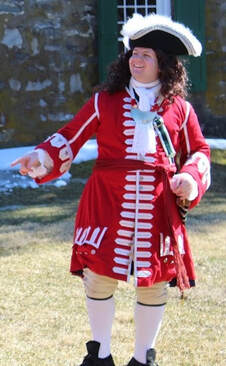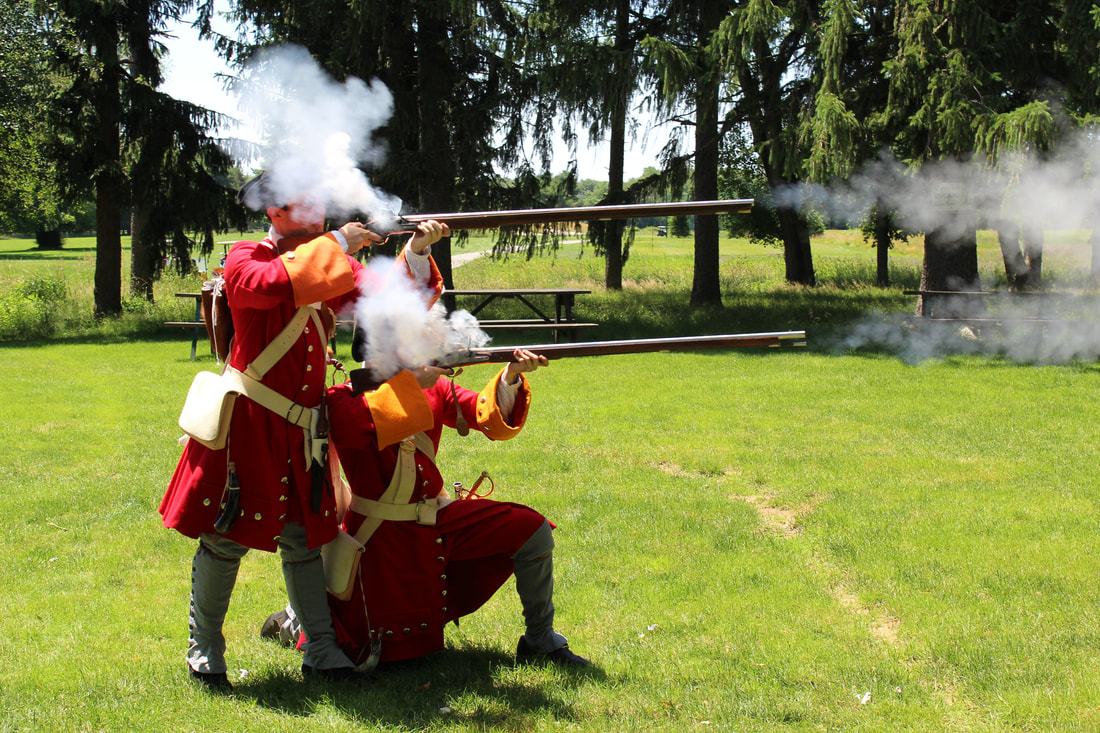Lord Donegall's Regiment of Foot
War of Spanish Succession 1702-1714

Prior to the Act of Union of 1707 which created the "British" army, there were technically three separate but united kingdoms with their own armies. England (which included Wales), Scotland, and Ireland were all linked and held in personal union with the sovereign under the Stuarts from King James I to Queen Anne.
Before regiments were given numbers (like 35), they were known by their colonels' names. On June 28, 1701, Arthur Chichester, 3rd Earl of Donegall, raised a regiment of infantry in Belfast at his own expense. This unit known as "Lord Donegall's Regiment of Foot" was given the right to wear orange facings by King William III as a mark of his royal favor. The orange would be proudly worn on the uniform until 1832 when the regiment became the "Royal Sussex".
Before regiments were given numbers (like 35), they were known by their colonels' names. On June 28, 1701, Arthur Chichester, 3rd Earl of Donegall, raised a regiment of infantry in Belfast at his own expense. This unit known as "Lord Donegall's Regiment of Foot" was given the right to wear orange facings by King William III as a mark of his royal favor. The orange would be proudly worn on the uniform until 1832 when the regiment became the "Royal Sussex".
The War of the Spanish Succession - Rise of the British Empire

A year after being raised, the regiment was deployed for overseas service in the War of Spanish Succession, a global war fought to prevent a union of France and Spain and their respective vast American empires. In the North American English colonies, the conflict was known as Queen Anne's War. English, Dutch, Danish, Catalan, and Austrian armies fought France, Bavaria, and pro-Bourbon Spaniards for the destiny of two continents.
The regiment's first action was Cadiz, Spain, in 1702, and it later served briefly in the Caribbean, then returned to campaign again in southern and eastern Spain. While the Duke of Marlborough campaigned successfully in north-western Europe, vexing the Marshals of France with victories at Blenheim, Ramillies, Oudenaarde, and Malplaquet, the allies enjoyed less overall success in Spain itself. The regiment captured and heroically defended Gibraltar against a Franco-Spanish force in 1705, earning its first Battle Honor, but the Anglo-Dutch and their anti-Bourbon Spanish allies were unable to overthrow Philip V in Madrid.
Early successes were undone when the allies were defeated at the Battle of Almansa in 1707. The regiment was badly mauled with many officers and men taken prisoner. The regiment's remnants returned to Ireland and the prisoners were repatriated in 1709. Frustrated, the British government was actively looking to end the seemingly unwinnable war. When peace was agreed upon, France had been humbled but was not crushed. Union with Spain was forbidden by the Treaty of Utrecht, achieving London's primary goal. Great Britain also found itself the dominant maritime nation and became, for the first time, a major global power.
The regiment's first action was Cadiz, Spain, in 1702, and it later served briefly in the Caribbean, then returned to campaign again in southern and eastern Spain. While the Duke of Marlborough campaigned successfully in north-western Europe, vexing the Marshals of France with victories at Blenheim, Ramillies, Oudenaarde, and Malplaquet, the allies enjoyed less overall success in Spain itself. The regiment captured and heroically defended Gibraltar against a Franco-Spanish force in 1705, earning its first Battle Honor, but the Anglo-Dutch and their anti-Bourbon Spanish allies were unable to overthrow Philip V in Madrid.
Early successes were undone when the allies were defeated at the Battle of Almansa in 1707. The regiment was badly mauled with many officers and men taken prisoner. The regiment's remnants returned to Ireland and the prisoners were repatriated in 1709. Frustrated, the British government was actively looking to end the seemingly unwinnable war. When peace was agreed upon, France had been humbled but was not crushed. Union with Spain was forbidden by the Treaty of Utrecht, achieving London's primary goal. Great Britain also found itself the dominant maritime nation and became, for the first time, a major global power.
The Recreated Regiment Today
|
The Royal Sussex Society recreates Lord Donegall's Regiment and hosts events in the New York/New Jersey area to educate and interpret the life and times of the War of Spanish Succession, or Queen Anne's War. Whether fielding the Marlburian soldiers of the Queen to demonstrate early 18th C. tactics and encampments, or the day-to-day lives of the men and women who followed and supported, the armies on campaign. Lord Donegall's signature event is the annual Days of King Louis & Queen Anne event in New York. We have also appeared at Lambert Castle, Dey Mansion, and the Royal Governor's Mansion in New Jersey and participated in the 1704 Raid on Deerfield event in Massachusetts.
|
"Who'll Be a Soldier with Marlborough and Me?" Join Today!
|
If you are interested in reenacting history with Lord Donegall's Regiment, Contact Us today to learn how! New recruits, whether military or civilian, will be given guidance and assistance to help them build up their clothing, equipment, and overall understanding of the period.
God Save the Queen! |
Officers Serving in 1702
This information below is provided only as a reference and a tribute to the officers of Lord Donegall's Regiment of Foot.
The Royal Sussex Society cannot assist with genealogical services.
The Royal Sussex Society cannot assist with genealogical services.

It is a sad reality that most of the Other Ranks who served in the regiment do not have their names preserved by surviving records. However, we are grateful for the work of Captain Richard Trimen who, in 1871, published a regimental history containing the names of many officers who served in the regiment. He was able to find and transcribe a list of those officers who made for the regiment's first trial by combat, Cadiz. Below we have the thirteen companies of the regiment with the officers and complements listed with notes, when possible, attached.
A company, at full strength, had a captain (who could be a rank higher than a "captain" but administratively filled the role of a captain as leader of a company), a lieutenant or captain-lieutenant, an ensign, 2 sergeants, 3 corporals, 2 drummers, and 45 private men. As the regiment was just leaving Ireland for war, the regiment was almost at 100% strength, although this would not last for very long.
Expedition for Cadiz, 1702
Maj. General Arthur Chichester, Earl of Donegall - Colonel of the Regiment, KIA 1706
Capt.-Lt. Joseph Delany
Ens. Tracy
2 Sgt., 3 Cpl., 2 Drummers, 45 Private Men
Lt. Col.-Capt. Peter Bristow - out 1706
Lt. Nathaniel Lane
Ens. Michael Bowmer - Spain 1702-07; wounded, prisoner when Capt, out 1708
2 Sgt., 3 Cpl., 2 Drummers, 41 Private Men
Capt. John Foulkes
Lt. Richard Collum
Ens. Isaac Ewdis
2 Sgt., 3 Cpl., 2 Drummers, 44 Private Men (2 sick)
Capt. Thomas Phillips
Lt. James Griffith
Ens. James Moore
2 Sgt., 3 Cpl., 2 Drummers, 43 Private Men
Capt. Edmond Keating
Lt. Francis Scott
Ens. Richard Willoughby
2 Sgt., 3 Cpl., 2 Drummers, 41 Private Men
Capt. Thomas Smith
Lt. Benjamin Wilkins
Ens. Peter Martin
2 Sgt., 3 Cpl., 2 Drummers, 40 Private Men
Major-Capt. William Hamilton
Lt. James Mallery
Ens. John Witchells
2 Sgt., 3 Cpl., 2 Drummers, 44 Private Men (1 sick)
Capt. Archibald Patton
Lt. Henry Deel
Ens. James Winn
2 Sgt., 3 Cpl., 1 Drummer, 45 Private Men (1 Drummer deserted)
Capt. E. De Mense Sourdney
Lt. George Foulkes
Ens. Henry Griffith
2 Sgt., 3 Cpl., 2 Drummers., 44 Private Men (1 died during time of writing)
Capt. James Sterling
Lt. Philip St. John
Ens. John Wallis
2 Sgt., 3 Cpl., 2 Drummers, 44 Private Men
Capt. Joshline Mead
Lt. Joseph Sanders
Ens. David Dudley
2 Sgt., 3 Cpl., 2 Drummers, 44 Private Men
Capt. Thomas Dancer
Lt. Flemming
Ens. Starling
2 Sgt., 3 Cpl., 2 Drummers, 44 Private Men
Grenadier Company - Aboard Prince of Orange
Officers and Men Unknown
Other Known Officers
Lt. Col. Richard Berkeley - 1708, out 1738
Major the Earl of Longford
Capt. Arthur Gore
Capt. John Davis - refused to go to West Indies, 1703, off half-pay
Capt. James Dore
Lt. George Holmes
Lt. John Pierce
Lt. John Reynolds
Ens. John Crofton
Ens. James Harrison
Ens. Nicholas Holmes
Ens. Stephen Ferragut
A company, at full strength, had a captain (who could be a rank higher than a "captain" but administratively filled the role of a captain as leader of a company), a lieutenant or captain-lieutenant, an ensign, 2 sergeants, 3 corporals, 2 drummers, and 45 private men. As the regiment was just leaving Ireland for war, the regiment was almost at 100% strength, although this would not last for very long.
Expedition for Cadiz, 1702
Maj. General Arthur Chichester, Earl of Donegall - Colonel of the Regiment, KIA 1706
Capt.-Lt. Joseph Delany
Ens. Tracy
2 Sgt., 3 Cpl., 2 Drummers, 45 Private Men
Lt. Col.-Capt. Peter Bristow - out 1706
Lt. Nathaniel Lane
Ens. Michael Bowmer - Spain 1702-07; wounded, prisoner when Capt, out 1708
2 Sgt., 3 Cpl., 2 Drummers, 41 Private Men
Capt. John Foulkes
Lt. Richard Collum
Ens. Isaac Ewdis
2 Sgt., 3 Cpl., 2 Drummers, 44 Private Men (2 sick)
Capt. Thomas Phillips
Lt. James Griffith
Ens. James Moore
2 Sgt., 3 Cpl., 2 Drummers, 43 Private Men
Capt. Edmond Keating
Lt. Francis Scott
Ens. Richard Willoughby
2 Sgt., 3 Cpl., 2 Drummers, 41 Private Men
Capt. Thomas Smith
Lt. Benjamin Wilkins
Ens. Peter Martin
2 Sgt., 3 Cpl., 2 Drummers, 40 Private Men
Major-Capt. William Hamilton
Lt. James Mallery
Ens. John Witchells
2 Sgt., 3 Cpl., 2 Drummers, 44 Private Men (1 sick)
Capt. Archibald Patton
Lt. Henry Deel
Ens. James Winn
2 Sgt., 3 Cpl., 1 Drummer, 45 Private Men (1 Drummer deserted)
Capt. E. De Mense Sourdney
Lt. George Foulkes
Ens. Henry Griffith
2 Sgt., 3 Cpl., 2 Drummers., 44 Private Men (1 died during time of writing)
Capt. James Sterling
Lt. Philip St. John
Ens. John Wallis
2 Sgt., 3 Cpl., 2 Drummers, 44 Private Men
Capt. Joshline Mead
Lt. Joseph Sanders
Ens. David Dudley
2 Sgt., 3 Cpl., 2 Drummers, 44 Private Men
Capt. Thomas Dancer
Lt. Flemming
Ens. Starling
2 Sgt., 3 Cpl., 2 Drummers, 44 Private Men
Grenadier Company - Aboard Prince of Orange
Officers and Men Unknown
Other Known Officers
Lt. Col. Richard Berkeley - 1708, out 1738
Major the Earl of Longford
Capt. Arthur Gore
Capt. John Davis - refused to go to West Indies, 1703, off half-pay
Capt. James Dore
Lt. George Holmes
Lt. John Pierce
Lt. John Reynolds
Ens. John Crofton
Ens. James Harrison
Ens. Nicholas Holmes
Ens. Stephen Ferragut



